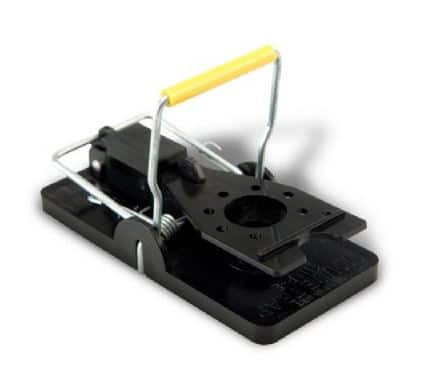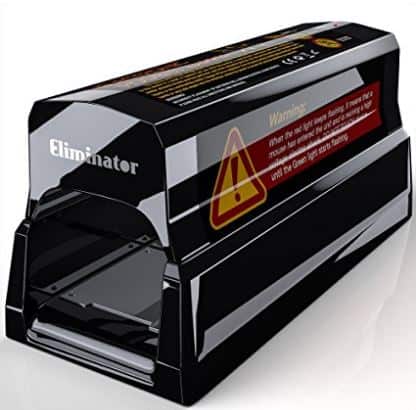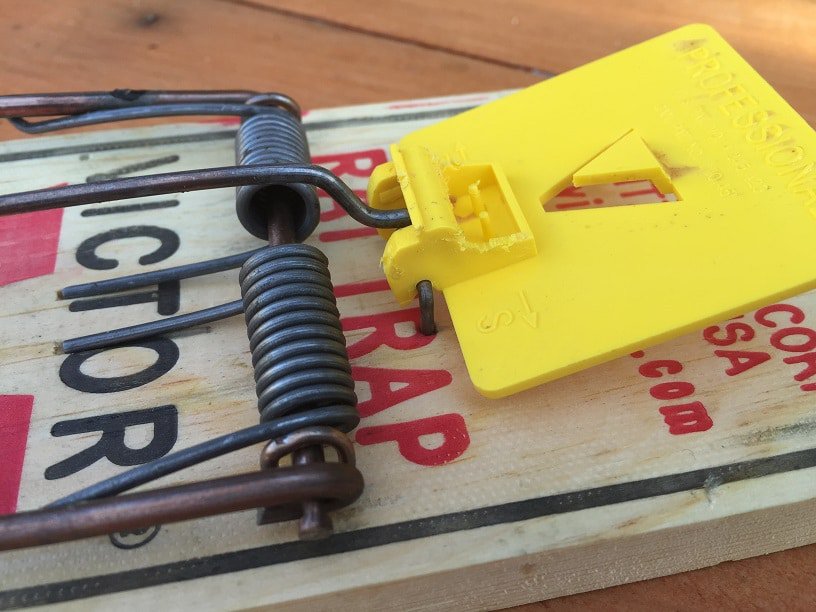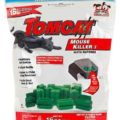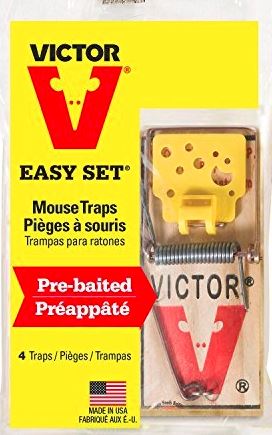Table of Contents
The best mouse trap is the one that solves YOUR problem the fastest. However, there are many types of mouse infestation situations so there is not a “one size fits all” solution when it comes to killing or trapping mice.
Quick Summary:
- Best Live Trap for Indoors: Mice Cubes
- Best Live Trap for Outdoors (chicken coop and garden): Victor Tin Cat
- Best Snap Trap: Kness Snap-E
- Best Electric Trap: Eliminator Rat Zapper
- Best Make It Yourself Trap: 5 Gallon Bucket Spinner
The best mouse trap for you depends upon questions like:
- Are the mice in your kitchen, attic or garden?
- Are you worried about your pets or kids getting hurt by the traps?
- Do you want to kill the mice or live trap them?
- Do you have a few mice or a LOT of them?
Let’s start by looking at the basic types of traps available and then see if we can figure out which will work the best for you.
Types Of Great Mouse Traps
Let’s start with what NOT to use: Glue Boards.
Yes, you can kill mice with glue boards. You will also kill lizards, chipmunks and birds. You also run a good chance of having the glue board wrapped around your pet’s back.
When you are successful killing mice with a glue board the mouse will die a slow, painful death.
I hate mice as much as the next guy but I see no need to slowly torture them to death.
Instead, let’s look at some high quality mice trapping options that are easy to use, affordable and humane.
Humane Mouse Traps
People have different ideas about what constitutes a humane trap. To some people it means a trap that does not hurt the mice while for others it means a quick kill trap where the mouse does not suffer.
I will cover the best of both options and will leave the true definition of humane for others to decide.
Live Mouse Traps for Indoors
Live traps can be just as effective as kill traps when it comes to catching mice. If you are using live traps then make sure you check them DAILY otherwise any mice you catch will die a slow death inside the trap defeats the purpose of live trapping.
The most common live traps are variations on a simple tube with a one way door. These traps are cost effective way of catching a single live mouse.
Below is a short video that walks you through a few of the most popular tube options. It’s a fun video that lets you see real mice getting caught but not harmed.
I have personally used the Mice Cube and can state that it worked GREAT for catching kitchen mice. The Tomcat option in the video also looks very effective.
I like the Mice Cubes because they worked for me and are highly affordable (about $10 for a four pack).
A tip for making the Mice Cubes even more effective is to use a double sided piece of duct tape to adhere the one side of the trap to the floor or wall. this prevents the slick plastic from sliding around on a wood floor or other smooth surface.
These single catch options are NOT useful for catching rats. Many rats are so long that the door never fully shuts when they enter the trap. If a rat does get caught then they are able to chew their way out of these plastic products.
Benefits of the tube style single catch live traps are:
- Great for catching a few small mice in your home
- EASY to use
- Will not harm cats, dogs or children
- An inexpensive and reusable product
These traps are not useful for:
- Catching rats
- Outdoor usage (easily destroyed by dogs, raccoons, etc)
- Large mouse infestations
Here is the link to buy these on Amazon: Mice Cubes
Live Mouse Traps for Outdoors
If you want to live catch mice that are in your chicken coop, garden or other outdoor areas then your best option is the Victor Tin Cat. The Tin Cat is works like a champ, can catch multiple mice at a time and is extremely sturdy for outdoor usage.
This trap will also catch (but not harm) chipmunks and voles. This openings on this device are typically too small to catch squirrels and moles.
Here is a great overview showing the Victor Tin Cat in action.
A nice feature of the Tin Cat trap is that you can bait the inside with multiple attractants. You can add some nuts, a piece of bread and a small dish of water to the device and greatly increase your chance of luring mice inside.
The ability to bait this device with a water dish makes it an excellent choice for catching the thirsty mice in you attic.
Benefits of the Victor Tin Cat Trap
- Great for outdoor use in a chicken coop or garden.
- Nice solution for large mouse populations
- Metal construction prevents mice chewing their way out
- Completely safe around pets and children
Limitations of the Tin Cat
- Not useful for catching squirrels
- Might be too bulky and unattractive for indoor use
Here is the link to buy the Tin Cat on Amazon: Victor Tin Cat
Make It Yourself Traps
You can modify a plastic 5 gallon bucket and create your own no kill trap capable of catching “bucket loads” of mice every night!
Most people who use this type of trap add water to the bucket so the mice drown. Drowning is a slow, panicked death that I do not consider to be humane. If you make a 5 gallon bucket trap please use it as a live trap.
Although you can make everything yourself as seen in the video there is also a very nice spinner that you can purchase and add to the bucket. It looks nicer and has great spinning action.
Here is the link to buy a bucket spinner on Amazon: 5 Gallon Bucket Spinner
Quick Kill Mouse Traps
For some people the thought of having to release a live mouse from a trap is completely terrifying. If that describes you then that’s okay…I understand!!
A lot of people just want the mouse to die as fast as possible and be done with the problem.
Snap Traps
The wooden Victor snap traps set the standard for many years but there are now much better snap trap options available.
The best snap trap on the market is the Snap E Mouse Trap from Kness.
These traps kill just as quickly as the wooden Victor traps but are so much EASIER TO USE!!
Here is a 30 second video showing how incredibly easy it is to set a Snap-E trap.
In addition to being easy to set, the Snap-E trap has other advantages over traditional snap traps.
The yellow band on the killing strike bar prevents the bar from cutting into the mouse. This greatly reduces the mess since there will be very little blood loss from the animal.
Because the mess is smaller and the trap is made from plastic you can easily clean the Snap-E trap and use it multiple times.
The downside to using any type of open snap trap is that their is a risk or it catching curious fingers and paws. It is unlikely that a Snap-E trap would break any finger bones if a child set it off but it would certainly hurt and result in bruising and tears.
Here is the link to buy the snap traps on Amazon: Kness Snap-E
Electric Mouse Trap
Rat Zappers are highly lethal and instant killing traps that work on mice and rats.
This was one of the main tools I used when getting rid of the rats in my attic.
A nice feature of an electronic mouse trap is that you never have to touch the dead mouse. You can simply pick up the whole device and pour the dead rodent into the trash.
Some people use rat zappers to kill squirrels. I mention this not because I think it is a good idea but as a warning for people who have small cats or dogs.
Given the potential dangers these devices pose to small pets think twice before using them in living areas. However these devices are GREAT for use in remote areas like attics.
Here is the link to buy the best rat zapper on Amazon: Eliminator Rat Zapper
How to Bait and Place Mouse Traps
The best mouse bait I have used is peanut butter. Although mice will gladly eat cheese using it to bait traps is a bit of a cartoon joke.
The choice of bait is much less important than where you place the traps.
Mice have very poor eyesight and use their whiskers to navigate by brushing them against walls. In homes with large infestations you can often see oily smear marks at the bottom of the walls from all of the mice rubbing against it as they go past.
Mice are also extremely good at learning and then repeating a safe travel route. This is why it is relatively easy to train mice to navigate mazes.
What this means is that if you can identify the paths that the mice are already traveling then all you need to do is put the traps in the path.
As you may have noticed already, mice are prolific poopers. Mice will poop and urinate along their trails as a way of communicating their breeding cycles with other mice.
If you can identify a poop trail then that is an ideal location to place a trap.
A final trapping tip is to trap as many mice as possible as fast as possible.
If you are using a single trap to catch one mouse per night then the mice will be breeding faster than you can catch them. Professional exterminators will often put out a dozen traps at a time. This also helps you catch a bunch of mice before they get smart and figure out what you are doing.

